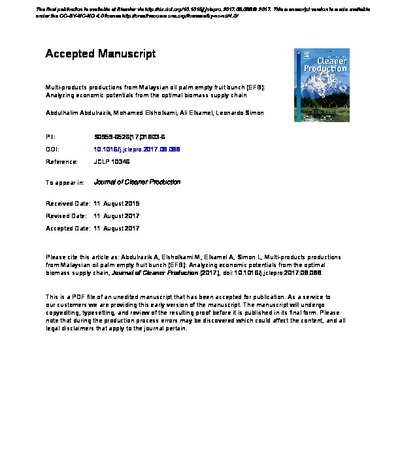| dc.contributor.author | Abdulrazik, Abdulhalim | |
| dc.contributor.author | Elsholkami, Mohamed | |
| dc.contributor.author | Elkamel, Ali | |
| dc.contributor.author | Simon, Leonardo | |
| dc.date.accessioned | 2017-09-22 18:10:28 (GMT) | |
| dc.date.available | 2017-09-22 18:10:28 (GMT) | |
| dc.date.issued | 2017-12-01 | |
| dc.identifier.uri | http://dx.doi.org/10.1016/j.jclepro.2017.08.088 | |
| dc.identifier.uri | http://hdl.handle.net/10012/12435 | |
| dc.description | The final publication is available at Elsevier via http://dx.doi.org/10.1016/j.jclepro.2017.08.088 © 2017. This manuscript version is made available under the CC-BY-NC-ND 4.0 license http://creativecommons.org/licenses/by-nc-nd/4.0/ | en |
| dc.description.abstract | The economic potentials of Malaysian oil palm empty fruit bunch are realized by several motivating factors such as abundance, cheapness and are generally feasible to produce multi-products that range from energy, chemicals and materials. Amid continuing supports from the government in terms of policies, strategies and funding, manufacturing planning and decision to utilize this biomass resource requires a decision-support tool. In this regard, biomass supply chain modeling serves as the supportive tool and can provide economic indications for guided future investments. Sequential steps in modeling and optimization of the supply chain that utilized empty fruit bunch were shown. In a form of superstructure, the supply chain consisted processing stages for converting the biomass into intermediates and products, transportation networks that used truck, train or pipeline, and the options for product's direct sales or for further refinements. The developed optimization model has considered biomass cost, production costs, transportation costs, and emission treatment costs from transportation and production activities in order to determine the annual profit. By taking a case study of Peninsula Malaysia, optimal value showed a profit of $ 713,642,269/y could be achieved which has assumed a single ownership for all of the facilities in the supply chain. Besides, the tabulated values of yields and emission levels could provide comparative analysis between the processing routes. Sensitivity analysis was then performed to perturb the approximated parameters or data that have been used in this study. | en |
| dc.description.sponsorship | Ministry of Higher Education of Malaysia | en |
| dc.description.sponsorship | Universiti Malaysia Pahang (UMP) | en |
| dc.description.sponsorship | Natural Sciences and Engineering Research Council of Canada (NSERC) | en |
| dc.language.iso | en | en |
| dc.publisher | Elsevier | en |
| dc.rights | Attribution-NonCommercial-NoDerivatives 4.0 International | * |
| dc.rights.uri | http://creativecommons.org/licenses/by-nc-nd/4.0/ | * |
| dc.subject | Bio-products; Biomass supply chain optimization; Empty fruit bunch (EFB); Palm oil industry; Superstructure | en |
| dc.title | Multi-products productions from Malaysian oil palm empty fruit bunch (EFB): Analyzing economic potentials from the optimal biomass supply chain | en |
| dc.type | Article | en |
| dcterms.bibliographicCitation | Abdulrazik, A., Elsholkami, M., Elkamel, A., & Simon, L. (2017). Multi-products productions from Malaysian oil palm empty fruit bunch (EFB): Analyzing economic potentials from the optimal biomass supply chain. Journal of Cleaner Production, 168(Supplement C), 131–148. https://doi.org/10.1016/j.jclepro.2017.08.088 | en |
| uws.contributor.affiliation1 | Faculty of Engineering | en |
| uws.contributor.affiliation2 | Chemical Engineering | en |
| uws.typeOfResource | Text | en |
| uws.peerReviewStatus | Reviewed | en |
| uws.scholarLevel | Faculty | en |


